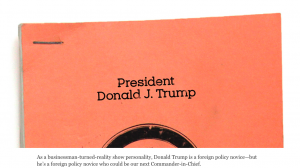Why “Imagine him in the White House” is such a bad advice
From a psychological perspective, the Clinton campaign has been piling up one mistake after another, starting with a silly slogan that featured their opponent’s name. This and quite a few other mistakes may be part of the reason why this race is still tight and that mrs Clinton may actually lose.
To give one example: what to think of the continuous warnings by the Clinton campaign “Imagine him in the Situation Room!” Mrs Clinton has been saying this for months now, and I just heard her repeating it again on CNN: Imagine him in the Oval Office!
Well, inviting the electorate to imagine that your opponent has won, may not be such a good strategy. For those who are still on the fence, repeatedly imagining mr Trump in the White House may make the idea just a little bit more acceptable.
As a clinical psychologist, I often see the power of imagination in clinical practice. This can go either way. People may become incapacitated more by imagined than by real dangers. But people may also become more likely to change their behavior by first imagining a different outcome.
For instance, if you have a fear of speaking in public you will tend to avoid that. Some people try to avoid any meeting in which they might have to say something. If you have a phobia, merely imagining a phobic situation will already provoke anxiety, which is why people will also avoid these mental images – they will try to push them away and think of something else.
The surprising thing that happens if you do not suppress these images, is that the anxiety will go down automatically – and usually a lot quicker than you would expect, sometimes within a minute. But if you have a phobia, you never get to that point because you will have avoided the image before the anxiety attenuates automatically.
The bottom line is: if you imagine yourself in a feared situation long enough, this situation becomes less frightening and more acceptable.
If you have trouble imagining mr Trump in the White House, the Clinton campaign is even helping you. This is what I found on the Clinton website, just two clicks away from the homepage:


Not many people will go on to read the listed reasons why Trump should not be calling the shots in the Situation Room. However, the image of a Presidential Briefing Paper with Trump’s name on it, might stick. Images stick easier than words anyway.
Not such a good idea, if you are running against him.
(This is an excerpt from my Cleveringa lecture, delivered on November 1st, 2016 in Washington DC)






Conversely, Trump is very good. See for example Scott Adams’ (creator of Dilbert cartoon) predicting a Trump win in February. At Scott’s recommendation, I have read the book “Pre-Suasion”, by Robert Cialdini. Trump has recently been saying how he at first didn’t like “Drain the swamp”, but when he saw how well it did, he started liking it. Obviously, this is pre-suading the audience to change their mind on Trump himself.
Thanks for your message, Willem. I agree, Trump is quite good at this. As pointed out by Scott Adams, the labels ‘low energy Bush’, ‘Lying Ted’ and others were very effective because they ring true.
Remarkable that no opponent has been able to come up with a label for Trump that sticks, shouldn’t be difficult at all.
I think that the labels stick that well because they are at first surprising, but hold up very well under close examination. This is more difficult to do with Trump. He often starts with what appears to be an extreme position, but upon closer examination is actually quite valid. (He also tones down after the issue moves to center stage.) The media tagged Trump as an unreliable ally when he asked questions about NATO’s purpose. This did not stick, because the original question is actually quite sensible. He was also able to enlarge his position by pointing out that many NATO countries (including the Netherlands) don’t meet their agreed 2%GDP NATO commitment. So there must be some tag out there that can be made to stick on Trump. However, it is not to be found among the issues that he so obviously waves in our face. For on those issues, he knows he has the goods to defeat the tag.
I don’t think it is so difficult and Clinton almost got it right:
Deplorable Donald would have stuck.
.